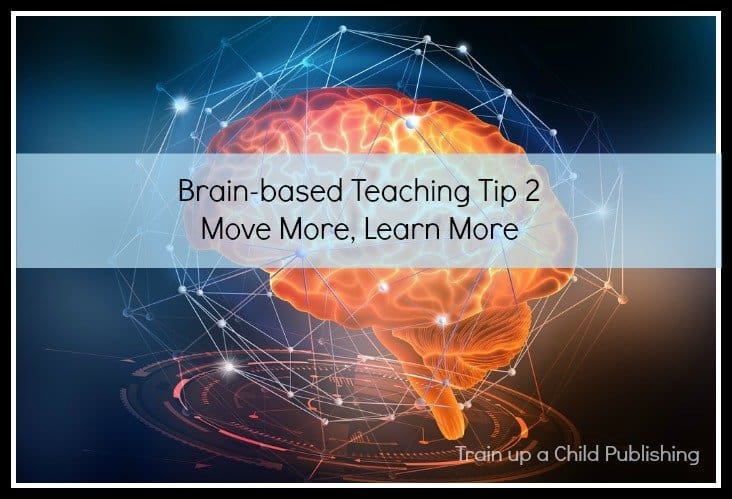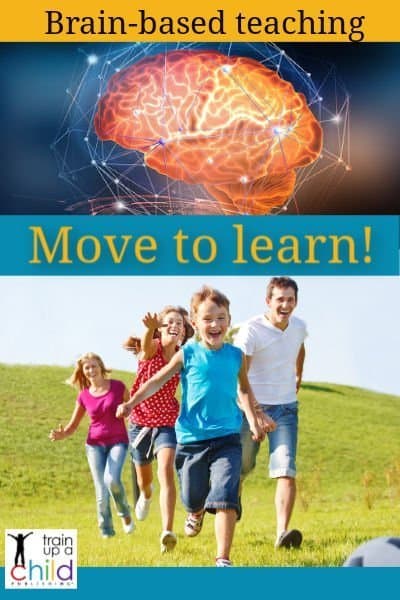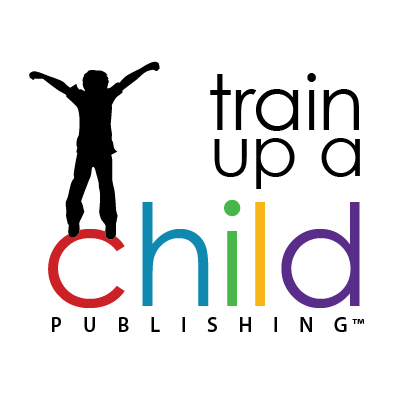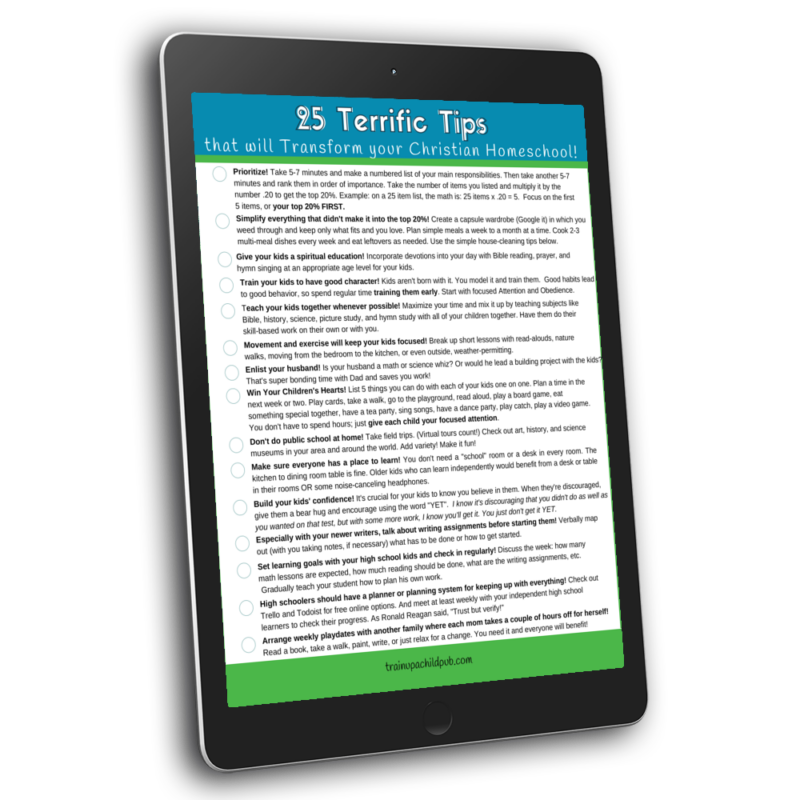Brain-based Teaching Tip 2 – Move to Learn

Children who move focus better, learn more quickly, and remember what they’ve learned longer than those sitting all day.
It only makes sense. If you are moving you’re getting more oxygen to your brain, right? It stands to reason that increased movement would help your children learn.
But movement does more than that. It helps your children focus. Moving gets your kids’ attention. It gets out the willies. It prepares your kids to listen.
So if you want to shake things up (in a great way) in your homeschool, remember: move to learn!
For a better understanding of how you learn more when you move more, watch this TEDx talk by Dr. John J. Ratey. He starts talking about exercise in schools at about the four-minute mark, but the best is at the end. He proves that movement has a huge effect on learning.
Movement will help YOUR kids learn better. Your homeschooled kids. Especially if you have a challenging child. (And we all have at least one, right?)
This is the second post in a blog series on brain-based teaching tips for your homeschool. There are links to related posts at the bottom of this post.
- Children who move focus better, learn more quickly, and remember what they've learned longer than those sitting all day.
- Your children's brains are engaged more when they are moving. So move more to learn more.
- Ideas you can use in your homeschool: movement to get more oxygen to little brains to help your children focus
- Integrate movement into all subjects
Editor’s Note: this post includes a few affiliate links to books we’ve used and loved. If you should buy something from one of our affliate links, we may earn a small commission, at no extra cost to you. Thank you for supporting us in this way!
Your children’s brains are engaged more when they are moving. So move more to learn more.
Susan Griss in her article, The Power of Movement in Teaching and Learning describes three scenarios much like these:
First Scenario: You’re lecturing your kids about the American Revolution. You’re talking. They’re listening (you hope).
Second Scenario: You and your children are having a joint discussion about the American Revolution.
Third Scenario: Your kids are working together practicing a dramatization they’d planned of a scene from an exciting novel about the American Revolution, such as Johnny Tremain.
Ms. Griss then asks, how much brain activity do you think would be generated by each example?
Of course – the third one will generate much more brain activity. Why?
In the third example, your kids are moving. They are engaged in every way– mentally, socially, emotionally, and physically.
Of course, their brains are going to be firing on more cylinders!

Research shows that students learn more when they move more.
According to Dr. Ratey’s video above, the more fit children are, the more their academic scores go up and the fewer behavioral issues they have. Win-win!
And some studies show that movement integrated into the subject being taught helps kids become more involved in and remember what they’re learning.
So, moving more prepares the brain to learn more effectively, moving more helps students focus, and moving more engages kids and helps cement learning.
Ideas you can use in your homeschool: movement to get more oxygen to little brains to help your children focus
Your students need daily exercise. And they need to move frequently during the day.
This applies to your high schooler as well as your kindergarten student. You think better when you have more oxygen in the brain.
So, break up periods of regularly sitting with any whole-body movement. It may be as simple as these examples:

Integrate movement into all subjects
In his ground-breaking book, Teaching with the Brain in Mind, Eric Jensen declares:
“Brain-compatible learning means that educators should weave math, movement, geography, social skills, role play, science, and physical education together.”
Here are ways to easily incorporate more movement into the different subjects you’re teaching. The movement might be related to the subject or not:
It may take some out-of-the-box thinking for you to get more movement into your learning, but this gives you a place to start.
And some of these activities will add a little more humor and fun to your day, which keeps your children engaged.
So, I’ve given you some ideas on how to add movement to your day while studying math, spelling, history/literature, and science.
What other ideas can you come up with to get your kids to move more so they can learn more? Have you noticed a difference when you’ve had your children move more?
Happy moving!

Related Posts about Brain-based Teaching
- Read the first post in this series: Brain-based Teaching Tips for your Homeschool.
- Get your children’s brains ready to learn: Turn listeners into learners by priming their brains.
- You’ve heard about subject integration? See how multisensory learning works.
- How to teach your children to believe in themselves


This is perfectly timed for the pending school year, Dana. It makes so much sense so I am happy to hear of the correlation yet at the same time I am sad for all those generations of kids (think Little House on the Prairie!) who were forced to sit for hours on end in school, at home or in church without moving a muscle. Not only is this tantamount to torture for some children or adults but it’s now proven to not be effective! Children with ADHD especially need to move in order to feel calm, centred and whole.
I know what you mean about feeling sorry for children who have to sit all day without the chance to move around! Torture is definitely not too strong a word for that. I’m glad brain research backs up what would seem common sense for anyone who has been around children. Thanks for sharing, Lisa!
I absolutely love this post! We are starting school again in a few weeks and this was a great reminder. When my son was little, he had a hard time sitting still for lessons so we did a lot of these. It made a huge difference in his learning. All children can benefit from these suggestions.
Thanks, Heidi. I had one just like your son — always moving! It’s been fascinating reading the research about the “move more, learn more” connection. I wish I had known about it much earlier.